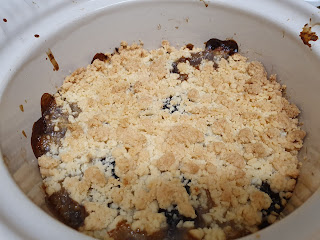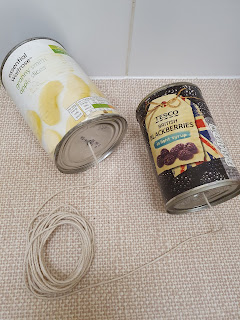More unusual tins today, this time on the fruit front: one of apples, and one of blackberries.
The blackberries (from Tesco) did come in a light syrup, which some of the juice and colour of the fruits had leached into - the berries themselves looked a more reddish purple than they might have been when picked. The label claimed that "Our juicy Loch Ness varieties are lovingly grown in Scotland." Lovingly grown? Given their abundance in the wild, I would have thought you could just let them get on with it without much love or attention required - unless these were cultivated like the ones you can buy in punnets. "They make the perfect partner for our British apples or just enjoy them on their own!" I hoped they would get on ok with the Waitrose apples. While cultivated supermarket blackberries tend to be somewhat firmer than the ones you might pick yourself, I suppose to give them a longer life, these ones were quite a bit softer, almost verging on being a little mushy. The flavour wasn't too bad though - the berries had that floral, ever-so-slightly spicy note to them, which is one of the joys of going blackberrying.
What to do with the fruit? Well, apple and blackberry are such good friends that I couldn't keep them apart - in her excellent Flavour Thesaurus, Niki Segnit brilliantly writes that they are "Like Simon and Garfunkel: perfectly respectable solo careers, can sell out Central Park together" - and it had to be a classic crumble really, didn't it? Into a dish they went, apples first, blackberries (drained of their syrup), and then the crumble topping scattered on top, and into the oven for just enough time to get the crumbs nicely browned - I reckoned that as the fruit was already softer than it would be using fresh, they wouldn't need as long a cooking time. It emerged bubbling, golden and delicious (not Golden Delicious - that's a different type of apple). If making my own crumble, I would usually use Bramleys or another cooking variety, which would soften and break down more. The pieces of Granny Smith (an 'eating' apple) were still quite discernible, and still with a little bit of bite to them, but I'm not sure you would you have known the fruit had come from tins if you hadn't been told.
Custard, of course, should be non-negotiable when it comes to crumble. But I foolishly had thought I had a tin in the cupboard, and this turned out not to be the case - schoolboy error. So I had to have it au naturel. No big deal, worse things have happened, and there was sufficient juice to mean it wasn't too dry, but ALWAYS CHECK YOU HAVE CUSTARD IN. I realised overnight that I should have served it with the little bit of evaporated milk in the fridge from another recipe, as that has a certain affinity with tinned fruit. So I was compelled therefore to try that for breakfast the next day. Cold crumble for breakfast is a Very Fine Thing Indeed - in fact, I had always intended to do that, so the evaporated milk was just an added bonus.
I had deliberately kept some of each fruit to try separately in different ways - the remaining apple pieces ended up being drizzled with a salted caramel sauce (I think the one I had made from the Tin Can Cook book last year), which was as excellent as it sounds. I had the blackberries with some melted white chocolate - sounds an odd combination, but another one which I came across in The Flavour Thesaurus, where Niki mentions how the spicy, floral notes of blackberries work well with the hint of vanilla in white chocolate. She suggests putting a small bar of white chocolate in your back pocket when you go blackberrying, which slowly melts as you fill your containers with berries, and then you can sit down, open up the bar, and dip some of your haul into the melted goo.
There had been plenty of the syrup from the blackberry tin left over too, to which I added some chopped rosemary to steep in it (another flavour combination I had read about elsewhere). This flavoured syrup then made a very nice addition to a gin and tonic, though I should probably have strained it first to get the bits out.
Finally, for the actual tins themselves, I'd long been meaning to try making a tin can telephone, making holes in the bottom of two cans and joining them with a length of string, which when pulled taught, allows you to speak into one tin and be heard by a friend at the other end of the string. And what could be more appropriate for this mobile communication device than an Apple and a Blackberry?

















No comments:
Post a Comment